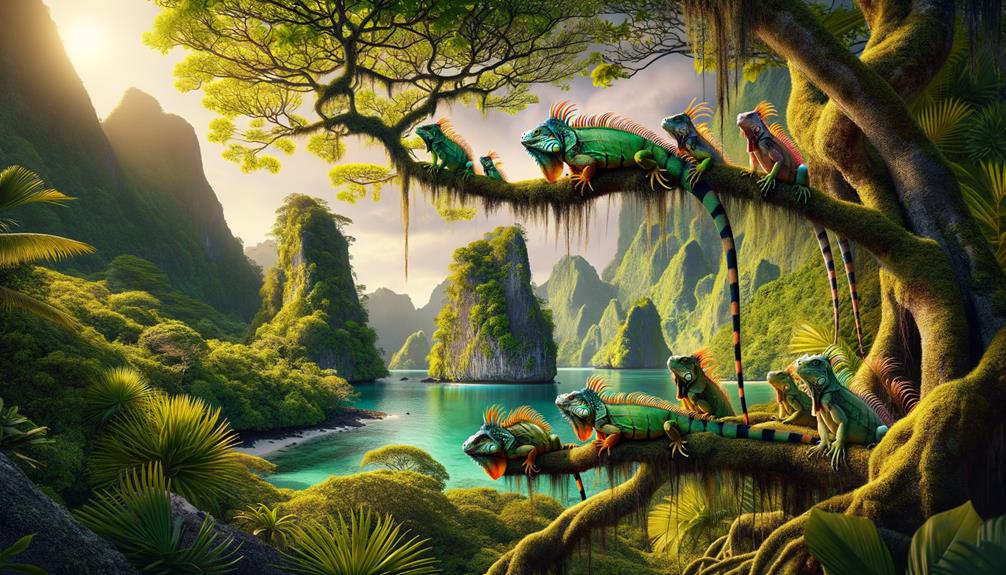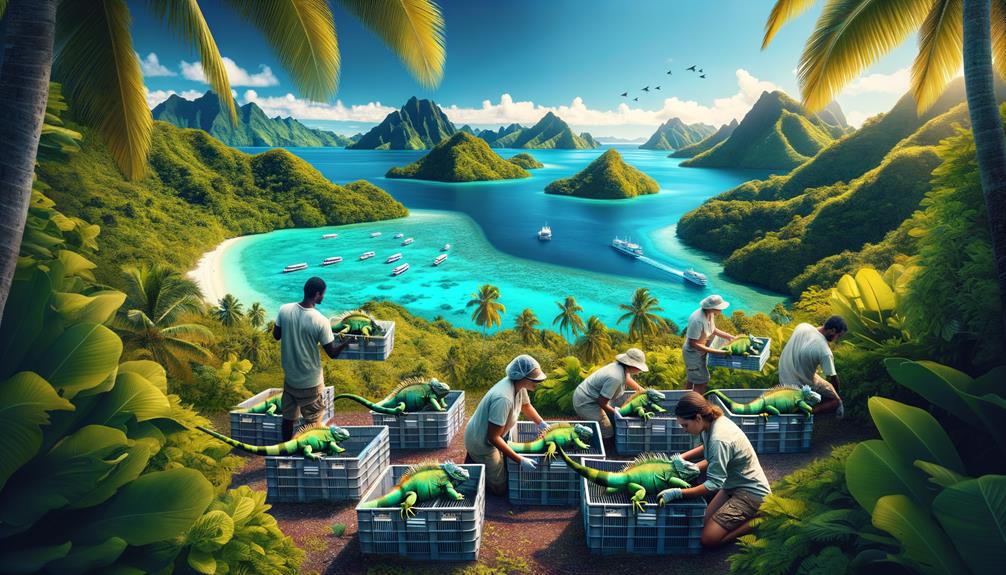I'm drawn to the Fijian crested iguana translocation effort, which received a substantial $16 million grant from the Global Environment Facility. This project focuses on restoring dry forests, particularly on Yadua Taba Island, to create a thriving habitat for the critically endangered iguana. The National Trust of Fiji is leading the conservation charge, closely monitoring the iguanas' health and adaptation. Collaborating with local communities is crucial in protecting the species, as they help tackle threats like invasive species and deforestation. By examining these comprehensive conservation strategies, we can gain a deeper understanding of what drives the protection of these incredible creatures.
Key Takeaways
The Fijian crested iguana translocation project has received a significant boost with $16 million in funding from the Global Environment Facility. This support will aid in the conservation and translocation of these unique creatures. Yadua Taba Island is playing a vital role as a genetic repository, helping to strengthen iguana populations in other Fijian habitats.
Collaboration with local communities is crucial, as they are essential in reporting poaching incidents and participating in habitat protection efforts. On Monuriki Island, breeding and release programs are underway to increase wild iguana populations. Ongoing monitoring and research are tracking iguana health, behavior, and threats, providing valuable insights to inform conservation strategies.
Translocation Plan Overview
The translocation plan for the Fijian crested iguana, backed by $16 million from the Global Environment Facility, is a meticulously designed effort to restore habitats, monitor species, and engage local communities in conservation efforts. As a herpetologist, I believe that integrating these components is crucial for the survival of this endangered species. The Fijian crested iguana, listed as endangered on the IUCN list, faces severe threats due to habitat loss and invasive species.
Our primary focus is on restoring dry forests, particularly on Yadua Taba Island, a critical habitat for the iguanas. These unique dry forests are the natural environment for the Fijian crested iguana, and their degradation has significantly impacted their population. The translocation plan involves moving these iguanas to restored habitats where they can thrive.
Tracking the iguanas is another vital aspect of the plan. By monitoring their health, behavior, and adaptation to new environments, we can gather valuable data that will inform ongoing and future conservation strategies.
Sanctuary on Yadua Taba

Yadua Taba Island is a vital haven for the Critically Endangered Fijian crested iguana, with a thriving population of around 12,000 individuals. The island's protected tropical dry forest ecosystem provides the essential resources these iguanas need to survive. The National Trust of Fiji leads conservation efforts, ensuring the island remains a safe haven for these remarkable creatures.
The significance of Yadua Taba as an iguana sanctuary cannot be overstated. The island serves as a stronghold for the species, shielding them from threats that have devastated populations elsewhere. Plans are underway to use Yadua Taba's flourishing population as a genetic repository to boost other habitats in Fiji.
Yadua Taba offers a secure refuge for these iguanas, thanks to its vital habitat. The National Trust of Fiji's conservation efforts have paid off, with the island's population serving as evidence of effective conservation. The plan is to use Yadua Taba as a source for repopulating other areas, ensuring the long-term survival of the species. The National Trust of Fiji plays a crucial role in safeguarding this critical habitat.
Community Collaboration

Amidst efforts to conserve the Critically Endangered Fijian crested iguana, local communities play a vital role in protecting their habitat through vigilant reporting and active participation. On Yadua Taba, the National Trust of Fiji works closely with community members to ensure the iguanas' survival. By encouraging locals to report illegal activities, especially poaching, a vigilant network is created that strengthens conservation efforts.
Community involvement is crucial. Engaging locals in decision-making processes fosters a sense of responsibility towards the iguana's critical habitats. This approach is vital for the long-term sustainability of conservation programs. The intricate ecosystems of Yadua Taba thrive when local knowledge and scientific expertise combine.
The partnership between the Fiji government, NGOs, and local communities highlights the importance of collective action. It ensures that conservation strategies are culturally sensitive, ecologically sound, and holistic. The community's active role in these efforts showcases a model of conservation where grassroots involvement is key.
Together, we're building a resilient framework that protects the endangered Fijian crested iguana and enriches the broader environmental and social fabric of the region.
Threat Management

Engaging local communities has laid the groundwork, but addressing predation by invasive species and habitat loss remains critical for the Fijian crested iguana's survival. The presence of predators and introduced animals, such as domestic cats, mongoose, and rats, continues to threaten these iguanas. These invasive species prey on eggs, juveniles, and even adult Fijian crested iguanas, making their survival precarious.
Deforestation, particularly of the tropical dry forests, has severely impacted the habitat of the Critically Endangered Fijian Crested Iguana. Protecting these unique ecosystems is vital for maintaining biodiversity and species survival.
Several conservation strategies are underway to manage these threats:
Breeding and release programs on Monuriki Island aim to boost wild populations. The Fiji Crested Iguana Sanctuary on Yadua Taba Island provides a safe haven for habitat preservation. Rigorous efforts are being made to control invasive species, reducing predation pressure. Active reforestation efforts are underway to restore and protect critical habitats. Ongoing monitoring and research track population dynamics and threats, informing conservation efforts.
Funding and Sustainability

Securing sustainable financing for conservation programs, like those protecting the Fijian crested iguana, is critical for mitigating threats and ensuring the long-term success of biodiversity initiatives. The Fijian government's allocation of $16 million from the Global Environment Facility (GEF) highlights the substantial commitment required. With the majority of this funding directed towards biodiversity and species protection, it's clear that robust financial support is vital.
Proposals for the upcoming GEF cycle seven meeting aim to secure additional funding to support the translocation, management, and awareness campaigns for endangered species like the crested iguana. This is crucial for preserving Fijian flora and fauna. Sustainable financing involves more than just securing funds; it requires strategic use over time.
Collaboration with communities and non-governmental organizations is essential for amplifying our efforts and fostering local stakeholder participation in conservation decisions. These partnerships are vital for effectively utilizing available resources and implementing long-term strategies.
Reliable funding sources remain a top priority to address ongoing threats to endangered species. Through the combined efforts of the Global Environment Facility and the International Union for Conservation of Nature, we can achieve comprehensive conservation that benefits both the iguanas and Fiji's broader ecosystem.
Frequently Asked Questions
Why Are Fiji Banded Iguanas Illegal in the Us?
Fiji banded iguanas are banned in the US because they're listed under CITES Appendix I, which prohibits their commercial trade. Keeping them without authorization interferes with conservation efforts and can lead to severe penalties under strict wildlife protection laws.
What Are the Interesting Facts About the Fiji Crested Iguana?
I find the Fijian crested iguana fascinating because of its vibrant green coloration and spiky crest. This species thrives in tropical dry forests, where males tend to be larger than females. Conservation efforts focus on translocation, habitat restoration, and sanctuary management to protect this unique creature.
What Is the Difference Between a Fiji Crested Iguana and a Fiji Banded Iguana?
The Fiji Crested Iguana features a distinctive spiny crest running along its neck, back, and tail, and can grow up to 31.5 inches in length. In contrast, the Fiji Banded Iguana is smaller and less vibrant, lacking this prominent crest.
What Are the Threats to the Fiji Crested Iguanas?
Imagine a T-Rex battling a mongoose. The Fiji crested iguana faces a multitude of threats. Habitat loss due to deforestation, predation by cats, mongoose, and rats, poaching, invasive plant species, and natural disasters like cyclones all jeopardize their survival.



